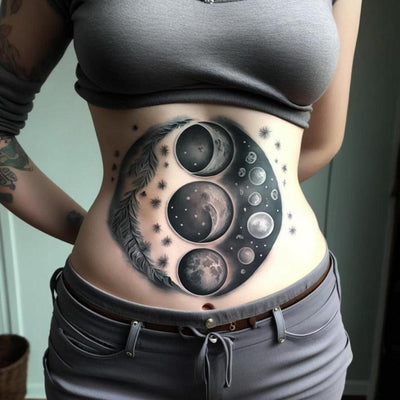Connaître le cycle de la Lune pour être en phase avec sa féminité
6 décembre 2022

Depuis la nuit des temps, la Lune fascine les hommes et les femmes. De nombreuses croyances associent cet astre changeant à la féminité ainsi qu’à la fertilité. En effet, le cycle lunaire et le cycle menstruel sont rythmés par des phases et présentent une durée quasi équivalente. Vous souhaitez en apprendre davantage sur le cycle de la Lune et l’ascendant qu’il peut posséder sur votre féminité ? Voici tout ce que vous devez savoir !
Qu’est-ce que le cycle lunaire ? Définition
Le cycle lunaire est la succession des phases de notre satellite. La Lune n’émettant pas de lumière, la lueur argentée qui nous parvient n’est autre que la lumière du Soleil se reflétant sur sa surface. Lorsqu’on l’observe depuis la Terre, elle revêt donc différents aspects en fonction de la position qu’elle occupe par rapport au Soleil.
Nous en apercevons également toujours le même hémisphère, appelé « face visible » en opposition à la « face cachée » que nous ne voyons jamais. Cet état de fait résulte du phénomène de rotation synchrone régissant la Lune. En effet, elle met sensiblement autant de temps à effectuer sa course autour de notre planète qu’à tourner sur elle-même (29,5 jours environ).
Tous les mois, nous pouvons admirer ses huit phases dans le ciel :
- la nouvelle Lune ou Lune noire (presque invisible à l’œil nu) ;
- le premier croissant de Lune ;
- le premier quartier de Lune ;
- la Lune gibbeuse croissante ;
- la pleine Lune ;
- la Lune gibbeuse décroissante ;
- le dernier quartier de Lune ;
- le dernier croissant de Lune.
Qu’est-ce que la lunaison ?
La lunaison, aussi appelée mois lunaire ou mois synodique, désigne l’intervalle de temps existant entre deux nouvelles Lunes consécutives. Elle ne doit pas être confondue avec le mois sidéral qui correspond au temps que la Lune met pour faire un tour complet de la Terre (27 jours 7 heures 43 minutes et 11,5 secondes).
Notre satellite et notre planète effectuant également leur révolution autour du Soleil, il en résulte un décalage de deux jours pour que la lumière du Soleil touche la Lune de la même manière qu’au début du cycle lunaire. La durée moyenne d’une lunaison s’élève donc à 29 jours 12 heures 44 minutes et 2,8 secondes.
Quelle est la durée d’un cycle lunaire ?
Un nouveau cycle lunaire recommence chaque fois que le Soleil, la Terre et la Lune se trouvent alignés. La durée de ce cycle correspond au temps d’une lunaison, soit 29 jours et demi.
Les règles féminines survenant tous les 28 jours en moyenne, le cycle menstruel et la Lune ont été comparés et rapprochés très tôt dans l’Histoire. D’après certaines croyances, les différentes phases du cycle lunaire et du cycle menstruel seraient intimement liées et se rapporteraient aux quatre grandes énergies de la vie : la naissance, la croissance, l’épanouissement et enfin la décroissance.
Dans une étude publiée en 2021 dans la revue Science Advances, des chercheurs ont pu confirmer l’hypothèse d’une relation entre la Lune et les menstruations. Selon eux, le cycle féminin et le cycle lunaire étaient vraisemblablement synchronisés durant l’Antiquité. Et ce serait notre mode de vie actuel, moins en phase avec la nature, ainsi que l’apparition des lumières artificielles et de la pilule qui auraient bouleversé cette harmonie.
Cycle de la Lune : comment nous influence-t-il ?
Vous avez certainement entendu parler de l’incidence des différentes phases de la Lune sur les marées. Notre satellite exerce en effet une force d’attraction sur la Terre qui entraîne l’augmentation ou la diminution de la masse d’eau en un point donné.
Mais saviez-vous que le cycle de la Lune pouvait également influencer les êtres vivants et en particulier les femmes ? Grâce aux travaux du professeur Marc Henry de l’Université de Strasbourg, cette influence a été démontrée scientifiquement.
Dans son ouvrage intitulé L’Eau morphogénique : santé, information et champs de conscience, le chercheur décrit un phénomène appelé « effet magnéto-gravitationnel ». Il explique que les ions traversant nos cellules créent un champ électromagnétique qui peut être stimulé par la force gravitationnelle de la Lune, mais aussi des planètes. Les horoscopes dressés par les astrologues traduiraient ainsi les influences que les astres possèdent sur nous.
Notre corps étant constitué à 65 % d’eau, nous subissons malgré nous l’influence de la Lune. Certains individus demeurent bien entendu plus réceptifs que d’autres et ressentent des effets différents en fonction de ses phases.
Au moment de la pleine Lune, il est possible de se sentir plus nerveux et fatigué, de souffrir d’insomnies et d’une légère perte d’appétit. D’autres phases de la Lune pourraient également jouer sur la pousse des cheveux, l’hydratation et la sensibilité de la peau.
Le cycle lunaire étant intimement lié à la période menstruelle, il possèderait aussi des effets supplémentaires chez la femme. S’ils n’ont pas encore été prouvés par la science, certaines personnes rapportent un syndrome menstruel plus prononcé ou des règles douloureuses à l’approche de la pleine Lune. Quoiqu’il en soit, prêter attention aux énergies lunaires et à leurs influences ne peut être que bénéfique pour se reconnecter avec la nature ainsi qu’avec soi-même.
Vous vous intéressez au cycle lunaire et à l’astrologie ? Sachez que la lunologie pourrait être une précieuse alliée. Cette pratique vise en effet à exploiter l’influence que le cycle lunaire peut exercer sur notre quotidien. Selon l’astrologue Yasmine Boland, chaque phase de la Lune se montrerait plus ou moins propice à la réalisation de certaines activités.
Afin de connaître la position de la Lune, référez-vous au calendrier lunaire de l’année en cours, qui répertorie les différentes lunaisons à venir. Ainsi, vous pourrez tirer le meilleur parti des énergies diffusées par cet astre lumineux et familier pour vous sentir en phase avec votre féminité.
La FAQ du cycle de la Lune
Combien de cycles lunaires y a-t-il par an ?
Une année comporte généralement douze ou treize cycles lunaires. En divisant la durée moyenne d’une année (365,25 jours) par celle d’une lunaison (29,5 jours), nous obtenons en effet un résultat situé entre 12 et 13.
Comment calculer le cycle de la Lune ?
Il n’est pas possible de calculer le cycle de la Lune de tête. Chaque lunaison possède une durée différente et diverses variables doivent être prises en compte. Pour connaître les phases de la Lune, vous pouvez utiliser un calendrier lunaire au format papier ou en ligne.


Commentaires